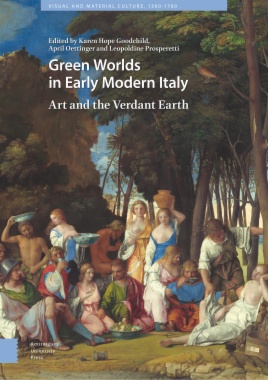The green mantle of the earth! This metaphor is a poetic image that borrows from the vocabulary of weaving and epitomizes the Renaissance interest in "fashioning green worlds" in art and poetry. Here it serves as a motto for a cultural poetics that made representing living nature increasingly popular across Italy in the Early Modern period. The explosion of landscape art in this era is often associated with the rise of interest in the literary pastoral, narrowly defined, but this volume expands that understanding to show Green’s broad appeal as it intrigued audiences ranging from the ecclesiastic to the medical and scientific to the humanistic and courtly. The essays gathered here explore the expanding technologies and varied cultural dimensions of verzure and verdancy in the Italian Renaissance, and thus the role of visual art in shaping the poetics and expression of greenery in the arts of the 16th-century and beyond.
- Half title page
- Series information
- Title page
- Copyright information
- Table of Contents
- List of Plates and Figures
- Introduction: A Fresh Vision of the Natural World in Renaissance Italy
- Earlier Green Voices
- Part One: Devotional Viridescence
- Part Two: Green Building
- Part Three: Sylvan Exchange
- Conclusions
- Part I. Devotional Viridescence
- 1. The Green Places of Fra Filippo Lippi and Sandro Botticelli
- Introduction
- Sensorial Medicine
- Verdant Materials
- Fra Filippo Lippi’s Technique
- Sandro Botticelli’s Technique
- Conclusion
- About the author
- 2. Anthropomorphic Trees and Animated Nature in Lorenzo Lotto’s 1509 St. Jerome
- Conclusion
- About the author
- 3. ‘Honesta voluptas’: the Renaissance
Justification for Enjoyment of the Natural World
- Part II. Building Green
- 4. “The Sala delle Asse as Locus amoenus: Revisiting Leonardo da Vinci’s Arboreal Imagery in Milan’s Castello Sforzesco”
- The Sala delle Asse and the Poetics of Vegetation at the Sforza Court
- Recent Technical Findings and the Sala delle Asse as Locus Amoenus
- The Sala delle Asse and the Gardens of the Castello Sforzesco
- About the author
- 5. Naturalism and Antiquity, Redefined, in Vasari’s Verzure
- Ephemeral Courtly Verzure
- Vasari’s use of Verzure in the Lives of the Artists
- Painted Verdure: ‘Rich, versatile, and abundant in invention and
craftsmanship’
- Verzure Masters: Giulio Romano and Rosso Fiorentino
- The Northern Roots of Verzure
- Giovanni da Udine: in alcune cose […] riuscire eccellentissimo
- Conclusion
- About the author
- 6. Verdant Architecture and Tripartite
Chorography: Toeput and the Italian
Villa Tradition
- Verdant Architecture
- Tripartite Chorography
- Conclusion
- About the author
- Part III. The Sylvan Exchange
- 7. Titian: Sylvan Poet
- A Corner of the Woods
- Woodblock Prints and Woodland Imagery
- Sylvan Poetics
- ‘[U]ne belle étude d’arbres’
- Silva
- Bacchanals
- Ecopoesis
- Conclusion
- About the author
- 8. From Venice to Tivoli: Girolamo Muziano and the ‘Invention’ of the Tiburtine Landscape
- 9. Of Oak and Elder, Cloud-like Angels, and a Bird’s Nest: The Graphic Interpretations of Titian’s The Death of St. Peter Martyr by Martino Rota, Giovanni Battista Fontana, Valentin Lefebre, John Baptist Jackson, and their Successors
- 10. The Verdant as Violence: The Storm Landscapes of Herman van Swanevelt and Gaspard Dughet
- The artists
- The debut of landscapes with stormy weather
- Precedents and origins of the land-storm in seventeenth-century landscape painting
- Landscape as metaphor
- Bad weather and climate change
- The literary traditions
- ‘We must sing of storms and flashing lightnings…’
- Synchronicity between Swanevelt and Dughet
- Implications for the future
- About the author
- Afterword: A Brief Journey through the Green World of Renaissance Italy
- About the author
- Primary Sources
- Secondary Sources
- Works Cited
- Index

